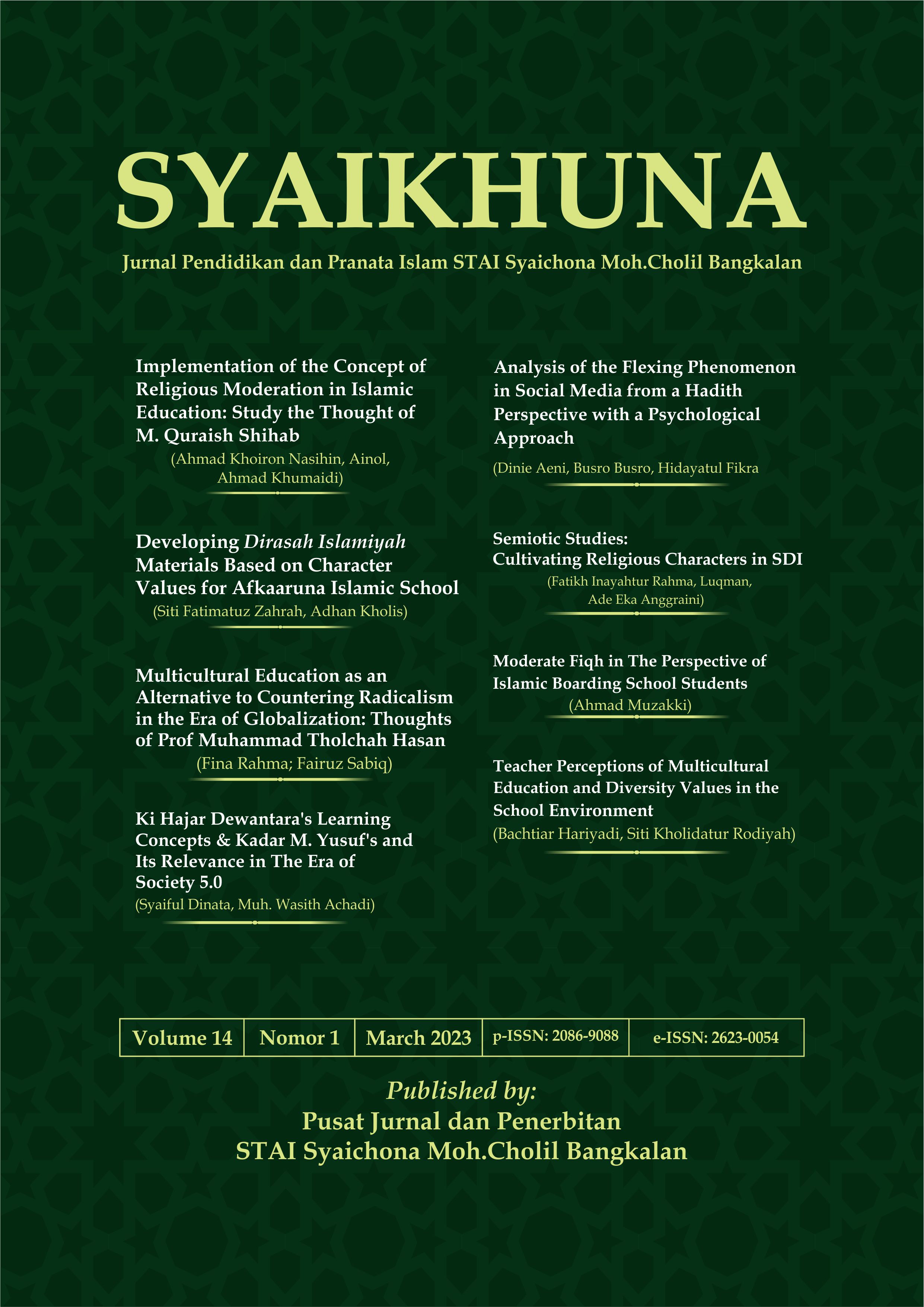Semiotic Studies: Cultivating Religious Characters in SDI
(Case Study in SDI KHA. Wahid Hasyim)
DOI:
https://doi.org/10.58223/syaikhuna.v14i01.6583Keywords:
Religious Character, Semiotic, Charles Sanders Pierce.Abstract
Implementation of character education must be familiar from an early age, especially religious character. A religious character is a human character based on religious aspects. One example of religious character planting activities is the dhuha and istighosah prayers. Semiotics is interpreted as a description of ideas, objects, and situations related to media, messages, culture, and society. The purpose of this research is to find out the message of cultivating religious character in SDI KHA. Wahid Hasyim is based on signs (icons, indexes, and symbols). This study uses a qualitative research approach presented in a descriptive form and analyzed by studying Charles Sanders Pierce's semiotic theory with the triangle theory of meaning, namely Icons, Indexes, and Symbols. The results of this study are 1) SDI KHA. Wahid Hasyim, as one of the Nahdlatul Ulama-based schools, implemented a religious character outside of the learning process by habituating the Dhuha prayer in congregation and regular istighosah every Thursday. 2) Dhuha and istighosah prayer activities have messages and culture that want to be instilled and conveyed to students from an early age. 3) signs such as body posture, setting of the place, and time have their meaning related to the cultivation of religious character.References
Ahsanulkhaq, M. (2019). Forming the Religious Character of Students Through the Habituation Method. Journal of Prakarsa Paedagogia, 2(1). https://doi.org/10.24176/jpp.v2i1.4312
Dwi, L., Syaroh, M., & Mizani, ZM (2020). Forming Religious Character by Habiting Religious Behavior in Schools. Indonesian Journal of Islamic Education Studies, 3, 63–82.
Hariyani, D., & Rafik, A. (2021). Habituation of Religious Activities in Forming Religious Character in Madrasas. AL-ADABIYAH: Journal of Islamic Religious Education, 2(1), 32–50. https://doi.org/10.35719/adabiyah.v2i1.72
Hatami, W. (2021). Representation of Character Values in the Lyrics of the 365 Day Paper Plane Song of JKT48. AL-TARBIYAH: Journal of Education (The Educational Journal), 31(1), 79. https://doi.org/10.24235/ath.v31i1.8387
Jannah, M. (2019). Methods and Strategies for the Formation of Religious Character Applied in SDTQ-T Najah Pondok Pesantren Cindai Alus Martapura. Al-Madrasah: Journal of Madrasah Ibtidaiyah Education, 4(1), 77. https://doi.org/10.35931/am.v4i1.178
Laela, K., & Arimbi, PA (2021). Formation of Students' Religious Character through Habituation of Shalawat and Asmaul Husna at SDN 2 Setu Kulon. Standardization of Elementary School Education Towards the Era of Human Society 5.0, 432–439.
Luthfiyah, R., & Zafi, AA (2021). Embedding Religious Character Values in the Perspective of Islamic Education in the RA Hidayatus Shibyan Temulus School Environment. Journal of the Golden Age, 5(02), 520–521.
Mahmudiyah, Awaliyani, M. (2021). ZAHRA: Research And Tought Elmentary School Of Islam Journal Formation Of Religious Character In Boarding Based Madrasah Ibtidaiyah. 2(1), 55–72.
Nurrahman, A., & Irawan, A. (2020). Analysis of the Level of Religious Character of Junior High School Students. Al-TA'DIB, 12(2), 171. https://doi.org/10.31332/atdbwv12i2.1575
Putra, KASA, Sugandi, & Arsyad, AW (2020). Cultural Representation of Indonesian Society's Tolerance in the Online Comic "Next Door Country." 8(1), 116–125. https://ejournal.ilkom.fisip-unmul.ac.id/site/wp-content/uploads/2020/01/JURNAL KELVIN (01-29-20-06-38-04).pdf
Sanah, Elly Zati Nur Alfi; Oemar, EAB (2021). Semiotic Analysis of Nussa and Rara's Character Education Values in the Nussa Season Two Animated Film. Journal of Fine Arts, 9(2), 287–298.
Saputri, L., Fatonah, K., Superior, UE, & Peirce, S. (2021). Peirce's Semiotic Study on Mandala Book Media. 2(2), 18–33.
Siregar, ED, & Wulandari, S. (2020). Charles Sanderspierce's Semiotic Study: Relationtricotomy (Icons, Indexes and Symbols) in the short story Lighthouse by Mashdar Zainal. Titian: Journal of Humanities, 04(1), 29–41. https://online-journal.unja.ac.id/index.php/titian
Siswanto, S., Nurmal, I., & Budin, S. (2021). Cultivating Religious Character Through the Habituation Method. AR-RIAYAH : Journal of Basic Education, 5(1), 1. https://doi.org/10.29240/jpd.v5i1.2627
Sukardi. (2013). Educational research methodology: competence and practice / Sukardi. Education - Research Methodology, Educational Research Methodology: Competence And Practice / Sukardi.
Downloads
Published
How to Cite
Issue
Section
License
Copyright (c) 2023 Fatikh Inayahtur Rahma, Luqman Luqman, Ade Eka Anggraini

This work is licensed under a Creative Commons Attribution 4.0 International License.





